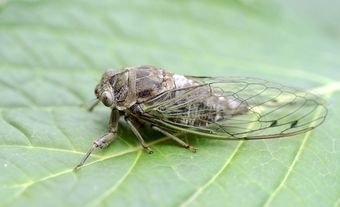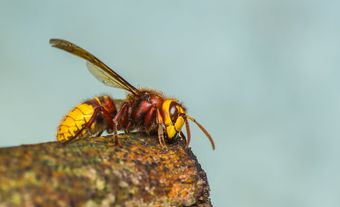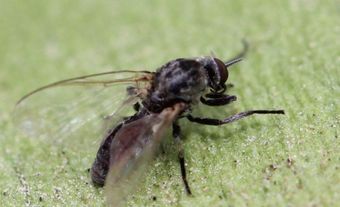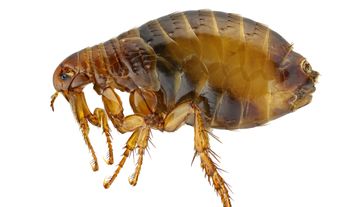Mantids are carnivorous insects of the order Mantodea, known for their prayer-like posture. Mantids are most closely related to cockroaches and termites. There are about 2,400 species worldwide, most of which are found in the tropics. Only three species are found in Canada: the European mantis (Mantis religiosa), the Chinese mantid (Tenodera aridifolia) and the ground mantid (Litaneutriaminor). Of these three species only the ground mantid, found in southern British Columbia, is native.
Although mantis is sometimes used to refer to the entire group, most entomologists prefer to use that word for members of the genus Mantis.

Description
Mantids are medium to large insects, 1-15 cm long, with a long thorax and powerful, grasping front legs used to capture prey. They have triangular heads, large, wide-set eyes, long, slender antennae and flexible necks. Mantids carry a pair of hearing structures (tympana) beneath their hind legs. Most species, including the two that are introduced to Canada (the European mantis and the Chinese mantid), have fully developed wings. In these species the leathery, narrow front wings protect the fan-like hind wings. Some species are flightless, however, and hunt by running across the ground. Canada’s native ground mantid has winged males, while females have reduced, non-functional wings.
Most mantids are cryptic (camouflaged) in colouration or form and may resemble leaves, twigs or flowers. The three species found in Canada rely on their colouration to blend into their surroundings: the European mantis and Chinese mantid range from bright, leaf-green to dull brown, while the ground mantid’s mottled brown colour is like that of a twig. This mimicry allows them to ambush unsuspecting prey. In other cases their mimicry is also used to attract prey, for example butterflies that pollinate the flowers being mimicked. Some mantids are mimics of ants or wasps.
When alarmed, mantids often rear up in threatening postures. When the European mantis does so, it reveals a pair of black-ringed white spots on the inner surface of its front legs, near their base. This mark distinguishes the European mantis from all other species found in North America.

Distribution and Habitat
Mantids are found in temperate and tropical parts of the world but are especially diverse in the tropics. Three species of mantids are found in Canada. The European mantis (Mantis religiosa) was accidentally introduced to New York State from Europe in 1899. It subsequently spread to Southern Ontario and Quebec and was later introduced to the Okanagan Valley, British Columbia, to control grasshoppers.
The Chinese mantid (Tenodera aridifolia) was introduced to Eastern North America from China in 1896 to control insect pests. The ground mantid, (Litaneutria minor) ranges from Mexico north to BC. It is the only mantid native to Canada, where its range is limited to the dry grasslands of the southern Okanagan Valley.
Reproduction and Development
Mantids have a reputation for cannibalistic mating, in which females eat males before, during, or after copulation. This is probably uncommon in the wild, and is more likely to happen when females are hungry. Males have evolved to be very cautious during mating: they approach females slowly and freeze to avoid detection if the female moves at all. After mating, the male retreats rapidly. Females lay their eggs in a frothy substance that hardens into a polystyrene-like case and glues the eggs to a twig, fence post or other support. The eggs overwinter and hatch in the spring. Mantids undergo incomplete metamorphosis, meaning that juveniles resemble small, wingless adults. Juveniles undergo several moults until they eventually develop into reproductively mature adults in the late summer.

Ecology
Mantids are voracious and indiscriminate predators. They are active during the day, and prey mostly on other arthropods. Mantids are ambush predators. They lie in wait for suitable prey, then use their large, grasping front legs to pounce on and seize their victim, which is usually eaten alive. Some larger species also prey on small frogs, lizards or hummingbirds. Mantids are the only insects conclusively shown to have binocular vision like humans. This allows them to accurately judge the distance to their prey. Their flexible “neck” also makes them the only group of insects able to look over their shoulders.
Relationship with Humans
Mantids are iconic in appearance, and many cultures have used them as symbols appearing in artwork, mythology and literature. As ambush predators, mantids spend much of their time motionless with their folded forelegs ready to strike. This prayer-like, seemingly meditative posture has given the entire group the familiar name “praying mantis.” Mantids may be kept as pets, or reared and sold as pest control agents, albeit ineffective ones, since they show no particular preference for preying on pests over beneficial insects like pollinators.

 Share on Facebook
Share on Facebook Share on X
Share on X Share by Email
Share by Email Share on Google Classroom
Share on Google Classroom







